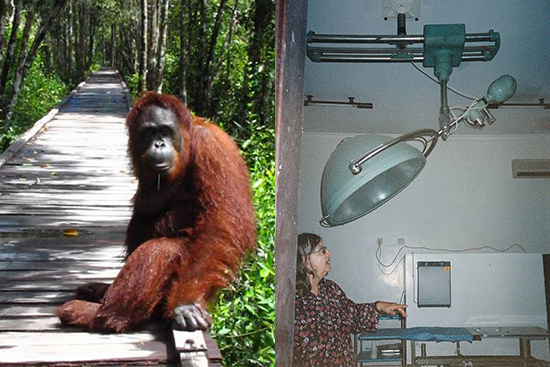Ask NASA Climate | January 7, 2015, 07:05 PST
Palm oil: A climate change culprit
Pictured here is a forest area being cleared for a palm oil plantation. Deforestation destroys wildlife habitats and adds massive amounts of carbon dioxide to the atmosphere. (Photo by Ian Singleton)

I always wanted to see orangutans in the wild, having learned that they are probably the most intelligent of all the great apes because of their ability to innovate and problem-solve. In 2007, I finally scraped together the funds to travel to Borneo—little did I know that at the age of 53, I would find my passion.
On my trip, I observed more incredible wildlife and natural beauty than I can possibly describe. I also saw acre after acre of once-pristine rainforests that had been transformed into barren moonscapes; rivers devoid of life and polluted by palm oil effluent and heavy metals; orphaned baby orangutans whose mothers were killed in palm oil plantations as agricultural pests. I learned that the forest home of many of these magical creatures is disappearing rapidly and suffering from the impacts of slash-and-burn agriculture.
Tracking forest changes from space
What is palm oil, what does it have to do with climate change and what does it have to do with NASA?
Palm oil is an edible vegetable oil from the fruit of the West African oil palm tree. It is used for biofuel, cosmetics, snack foods, ice cream, lotion and soap, and is in about half of all products on store shelves. The oil palm tree is grown in tropical regions (mostly in Indonesia and Malaysia, but now spreading all over the tropics, including Africa), and rain forests are being cleared to make room for more of this crop. Since rain forests are the largest carbon sinks, when destroyed they release massive amounts of carbon dioxide. Deforestation is the second largest manmade source of atmospheric carbon dioxide, after fossil fuel burning.
NASA satellites make it possible for scientists to monitor changes in rainforest landscapes around the world and to collect images of areas that are actively burning (here and here). In addition, the AIRS instrument on the Aqua satellite can keep an eye on the carbon monoxide produced from these fires. These satellites and instruments are part of a fleet of 18 Earth-observing satellites that are monitoring our home planet 24/7.
For more information, visit http://www.nasa.gov/content/earth-right-now/.
Images of my Jakarta journey
The following is an album, in words and images, of my life-changing visit to Indonesia.


Traveling to Tanjung Puting National Park in Borneo required two more flights and a slow trip on a funny wooden boat called a "klotok." I soon forgot about the palm oil and poor air quality in Jakarta (or so I thought) and enjoyed the natural beauty of the forest along the pristine black water Sekonyer River.


When we arrived at the dock of Camp Leakey, Siswi, one of the resident orangutans, greeted us. She and several other orangutans ran to hold hands with Dr. Birute Galdikas, who established the camp back in 1971. Siswi was a bit of a troublemaker, immediately getting into a guest’s backpack and breaking into the lunchroom. I was fascinated to watch her mix herself a drink (non-alcoholic) and show her affection by holding our hands and ankles. I quickly fell in love with these creatures, who appear so different physically from us but have many human characteristics.
On the trip, I also visited the Orangutan Care Center, where locals bring confiscated, sick, injured and orphaned orangutans for veterinary care. Soon after I arrived, a baby came in, and I couldn’t help but ask what happened. I was told that many orphans are “palm oil orphans” whose forest habitats were destroyed—and parents killed—by the swiftly spreading palm oil industry in Indonesia.

I returned home, determined to do something about palm oil, and enrolled in graduate school in environmental policy and management. I joined the board of a local non-profit organization dedicated to protecting orangutans in the wild. As an Non-Governmental Organization, we joined the Roundtable on Sustainable Palm Oil, which promotes palm oil production practices that help reduce deforestation, preserve biodiversity, respect the livelihoods of rural communities and ensures that no new primary forest or other high conservation value areas are sacrificed for palm oil plantations.
